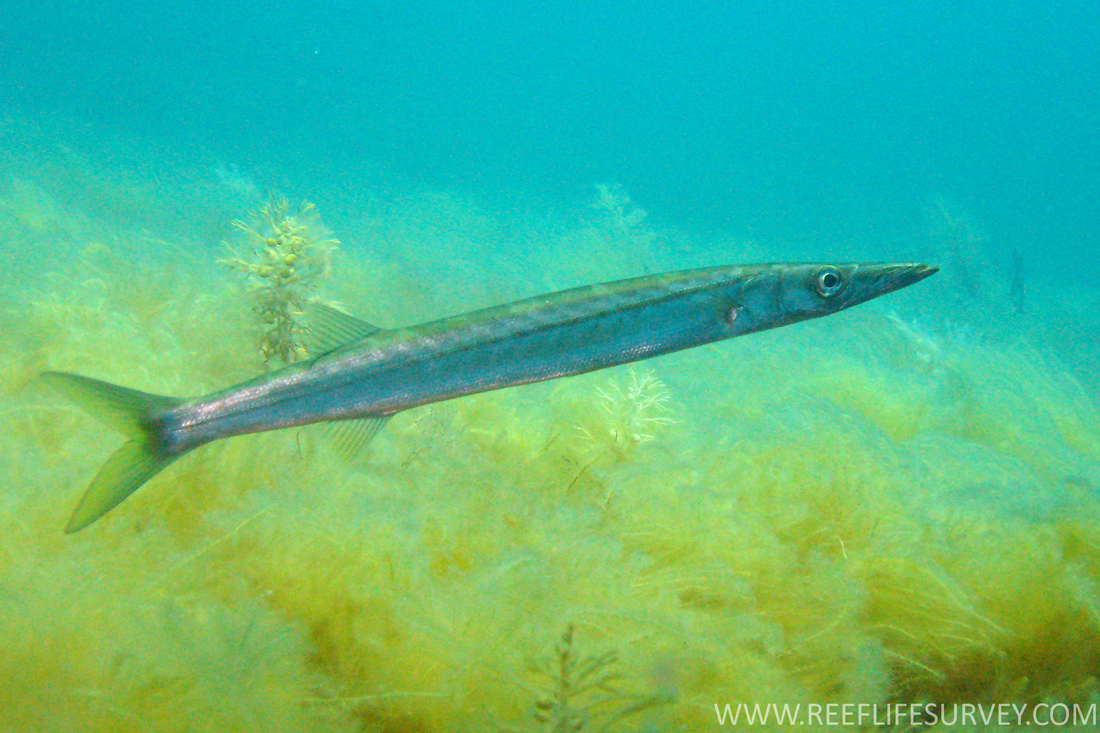- Classification
- ACTINOPTERYGII
- PERCIFORMES
- SPHYRAENIDAE
- Sphyraena
- novaehollandiae
Snook, Sphyraena novaehollandiae Günther 1860

A Snook, Sphyraena novaehollandiae, in Gulf St Vincent, South Australia. Source: Rick Stuart-Smith / Reef life Survey. License: CC by Attribution
A silvery green barracuda becoming silver below, with greenish or pale yellowish-green fins.
Snook is a prized eating species in Victoria, South Australia and Western Australia, where it occurs in bays and estuaries.
Snook, Sphyraena novaehollandiae Günther 1860
More Info
|
Distribution |
Southern Australia from eastern Victoria to Jurien Bay, Western Australia, including Tasmania. Elsewhere the species occurs in New Zealand. Individuals or large schools occur over seagrass beds and kelp reefs, often along reef edges with sand and seagrass patches. They also occur in protected bays, and are relatively common in Port Phillip, Victoria. |
|
Features |
Dorsal fin VI + I, 9; Anal fin II, 9-10; Caudal fin 17; Pectoral fin 13; Pelvic fin I, 5; Gill rakers (first arch) 1; Lateral line (pored scales) 120-138; Scales above lateral line 9-11; Scales below lateral line 11-13. Body very slender, almost cylindrical, depth 9-11% SL); caudal peduncle of moderate length. Head distinctly pointed (27-33% SL); mouth large (upper jaw length 33-37% HL), horizontal, maxillae distinctly not reaching to below eyes, separated from it by eye diameter; lower jaw protruding in advance of upper; teeth prominent, flattened, distinctly pointed, lower jaw often with one or two large canines anteriorly, row of moderately small teeth laterally; upper jaw with row of tiny teeth; roof of mouth with two pairs of fangs anteriorly and row of about five large teeth along each side; preopercles without produced membranous flap at angle; first gill arch with prominent gill raker at angle only. Scales tiny, cycloid; lateral line nearly straight; 10-12 scales between lateral line and first dorsal fin. Two widely separated dorsal fins of similar size, each with short base, origin of first above or slightly in advance of ventral fin origins, both well behind tip of pectoral fins; anal fin similar to and opposite second dorsal fin; caudal fin forked. Pectoral fins small, pointed, pectoral-fin tip does not reach to below the origin of the first dorsal fin. Pelvic fins small, origin well behind tip of pectoral fins. |
|
Size |
To more than 100 cm and about 6 kg. Can reach 20 years of age. |
|
Colour |
Greenish dorsally, silvery on sides, fading to white ventrally. Greenish-yellow caudal fin. |
|
Feeding |
Voracious opportunisitc predators that actively hunt small fishes such as schooling baitfish (pilchards, anchovies, hardyheads and garfish), squid and bottom-dwelling fishes and crustaceans. |
|
Fisheries |
Although of little interest to commercial fishers, Snook are prized by recreational fishers and are commonly caught on a lure. The flesh is considered excellent eating. |
|
Conservation |
None. |
|
Etymology |
From the Latin, novaehollandiae meaning New Holland, in reference to the type location. |
|
Species Citation |
Sphyraena novaehollandiae Günther 1860, Cat. fishes British Museum 2:335. Type locality: Hobson's Bay, Port Phillip, Victoria, Australia. |
|
Author |
Bray, D.J. & Schultz, S. 2020 |
|
Resources |
Snook, Sphyraena novaehollandiae Günther 1860
References
Edgar, G.J. 2008. Australian Marine Life: the plants and animals of temperate waters. Sydney : Reed New Holland 2nd edn, 624 pp.
Edgar, G.J. & Shaw, C. 1995. The production and tropic ecology of shallow-water fish assemblages in Southern Australia. II. Diets of fishes and tropic relationships between fishes and benthos at Western Port, Victoria. Journal of Experimental Marine Biology and Ecology 194: 83-106.
Gomon, M.F. 1994. Family Sphyraenidae. pp. 664-667 figs 582-585 in Gomon, M.F., Glover, C.J.M. & Kuiter, R.H. (eds). The Fishes of Australia's South Coast. Adelaide : State Printer 992 pp. 810 figs.
Gomon, M.F. 2008. Families Sphyraenidae to Centrolophidae. pp. 774-800 in Gomon, M.F., Bray, D.J. & Kuiter, R.H. (eds). Fishes of Australia's Southern Coast. Sydney : Reed New Holland 928 pp.
Günther, A. 1860. Catalogue of the Fishes in the British Museum. Catalogue of the acanthopterygian fishes in the collection of the British Museum. Squamipinnes, Cirrhitidae, Triglidae, Trachinidae, Sciaenidae, Polynemidae, Sphyraenidae, Trichiuridae, Scombridae, Carangidae, Xiphiidae. London : British Museum Vol. 2 548 pp. See ref at BHL
Hutchins, J.B. & Swainston, R. 1986. Sea Fishes of Southern Australia. Complete field guide for anglers and divers. Perth : Swainston Publishing 180 pp.
Kuiter, R.H. 1993. Coastal Fishes of South-eastern Australia. Bathurst : Crawford House Press 437 pp.
Last, P.R., Scott, E.O.G. & Talbot, F.H. 1983. Fishes of Tasmania. Hobart : Tasmanian Fisheries Development Authority 563 pp. figs.
May, J.L. & Maxwell, J.G.H. 1986. Field Guide to Trawl Fish from Temperate Waters of Australia. Hobart : CSIRO Division of Marine Research 492 pp.
Scott, T.D., Glover, C.J.M. & Southcott, R.V. 1974. The Marine and Freshwater Fishes of South Australia. Adelaide : Government Printer 392 pp. figs.
Senou, H. 2001. Sphyraenidae. pp. 3685-3697, in Carpenter, K.E. & Niem, V.H. (eds) The Living Marine Resources of the Western Central Pacific. FAO Species Identification Guide for Fisheries Purposes. Rome : FAO Vol. 6 pp. 3381-4218.
Whitley, G.P. 1947. New sharks and fishes from Western Australia. Part 3. The Australian Zoologist 11(2): 129-150 figs 1-3 pl. 11
Yearsley, G.K., Last, P.R. & Ward, R.D. (eds) 1999. Australian Seafood Handbook. Hobart : CSIRO Marine Research 460 pp.





